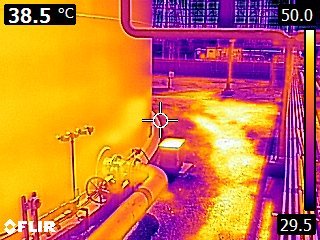
Thermal Imaging
Leak and Sediment Inspections
Infrared thermography (IRT), or Thermal Imaging,
is a process where a thermal camera captures and creates an image of an object by using infrared radiation emitted from the object in a process, which are examples of infrared imaging science. Thermographic cameras usually detect radiation in the long-infrared range of the electromagnetic spectrum (roughly 9,000–14,000 nanometers or 9–14 μm) and produce images of that radiation, called thermograms. Since infrared radiation is emitted by all objects with a temperature above absolute zero according to the black body radiation law, thermography makes it possible to see one's environment with or without visible illumination. The amount of radiation emitted by an object increases with temperature; therefore, thermography allows one to see variations in temperature. When viewed through a thermal imaging camera, warm objects stand out well against cooler backgrounds; humans and other warm-blooded animals become easily visible against the environment, day or night. As a result, thermography is particularly useful to the military and other users of surveillance cameras.
Fields in which these techniques are used:
Commercial and Residential, roof and insulation check
Industrial, asset maintenance (above ground storage tank, vessel inspections)
Program process monitoring
Quality control in production environments
Predictive maintenance (early failure warning) on mechanical and electrical equipment
Agriculture, e.g., Seed-counting machine
Building inspection
Fault diagnosis and troubleshooting
Energy auditing of building insulation and detection of refrigerant leaks
Roof inspection
Home performance
Moisture detection in walls and roofs (and thus in turn often part of mold remediation)
Masonry wall structural analysis
Thermography (medical) - Medical testing for diagnosis
Veterinary thermal imaging
Applications
-

Commercial and Residential - Roof or Insulation Inspections
Thermal imaging is a great and quick way to inspect the condition of a large size roof making sure it is not leaking.
-

Industrial use - Ash or Sediment Inspections
The quickest way to locate potential clogs or sediment built up on the interior side of the storage tank or check the ash contamination level inside.
-

Industrial use - Valve condition check
It is the most effective way to find the potential clog or clogs in the piping system.

